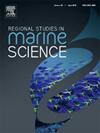陆基水产养殖对沿海有机质和养分负荷的主导贡献:韩国济州岛颗粒有机碳和铵通量的量化
IF 2.4
4区 环境科学与生态学
Q3 ECOLOGY
引用次数: 0
摘要
陆基水产养殖场(LAFs)在韩国济州岛迅速扩张,引发了人们对其对沿海生态系统环境影响的担忧。然而,硫酸盐对海岸养分负荷的定量贡献仍未得到充分的了解。本研究通过测量2019年春、夏、秋三个季节四个代表性养殖场的进、流出物中颗粒有机碳(POC)、溶解有机碳(DOC)和溶解无机营养物(DIN、DIP、DSi)的浓度,量化了济州岛养殖场主要污染物的净通量。虽然医生的废水浓度、德标DIN、探底,和DSi与入渗的水平,POC和铵(NH₄⁺)浓度明显高于在废水(66 ± 24 µM和24 ± 12 µM,分别)比支流(7.5 ±1.0 µM和0.8 ±0.2 µM,分别),识别主要污染物与水产养殖活动相关。出水POC浓度在夏季达到峰值,与饲养率的增加相一致。利用捕获进食引起的变化的时间序列观测,估计济州岛所有LAFs中POC和NH₄⁺的年净通量分别为35.7 × 10⁷mol yr - 1和16.6 × 10⁷mol yr - 1。值得注意的是,LAFs中NH +的通量大约是海底地下水排放(SGD)和污水处理厂(WWTPs)总通量的10倍,这表明LAFs是济州岛沿海水域生物有效氮的主要来源。这些研究结果表明,迫切需要修订现行的环境法规,实施针对水产养殖废水的特定营养标准,以减轻富营养化,保护济州岛沿海生态系统的生态完整性。本文章由计算机程序翻译,如有差异,请以英文原文为准。
Dominant contribution of land-based aquaculture to coastal organic matter and nutrient loads: Quantifying particulate organic carbon and ammonium fluxes from Jeju Island, South Korea
Land-based aquaculture farms (LAFs) are rapidly expanding on Jeju Island, South Korea, raising concerns about their environmental impact on coastal ecosystems. However, the quantitative contribution of LAFs to coastal nutrient loading remains inadequately understood. This study quantified the net fluxes of key pollutants from LAFs on Jeju Island by measuring concentrations of particulate organic carbon (POC), dissolved organic carbon (DOC), and dissolved inorganic nutrients (DIN, DIP, DSi) in the influent and effluent of four representative farms during the spring, summer, and autumn of 2019. Although the effluent concentrations of DOC, DIN, DIP, and DSi were comparable to influent levels, POC and ammonium (NH₄⁺) concentrations were significantly higher in the effluent (66 ± 24 µM and 24 ± 12 µM, respectively) than in the influent (7.5 ± 1.0 µM and 0.8 ± 0.2 µM, respectively), identifying them as primary pollutants associated with aquaculture activities. Effluent POC concentrations peaked in the summer, coinciding with increased feeding rates. Time-series observations capturing feeding-induced variations were used to estimate the net annual fluxes of POC and NH₄⁺ from all LAFs on Jeju Island at 35.7 × 10⁷ mol yr−1 and 16.6 × 10⁷ mol yr−1, respectively. Notably, the NH₄⁺ flux from LAFs was approximately 10 times greater than the combined fluxes from submarine groundwater discharge (SGD) and wastewater treatment plants (WWTPs), establishing LAFs as the primary source of bioavailable nitrogen in the coastal waters of Jeju Island. These findings highlight the urgent necessity for revising current environmental regulations by implementing nutrient-specific standards for aquaculture effluent to mitigate eutrophication and protect the ecological integrity of coastal ecosystems on Jeju Island.
求助全文
通过发布文献求助,成功后即可免费获取论文全文。
去求助
来源期刊

Regional Studies in Marine Science
Agricultural and Biological Sciences-Ecology, Evolution, Behavior and Systematics
CiteScore
3.90
自引率
4.80%
发文量
336
审稿时长
69 days
期刊介绍:
REGIONAL STUDIES IN MARINE SCIENCE will publish scientifically sound papers on regional aspects of maritime and marine resources in estuaries, coastal zones, continental shelf, the seas and oceans.
 求助内容:
求助内容: 应助结果提醒方式:
应助结果提醒方式:


